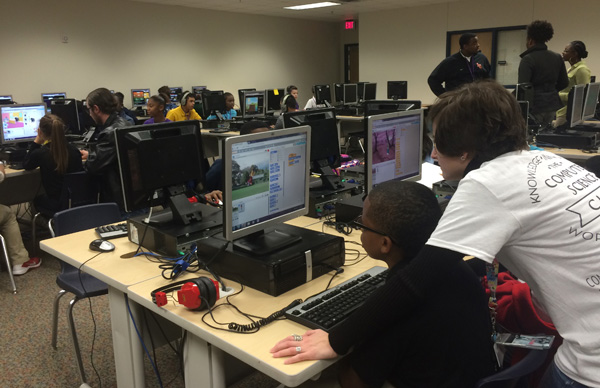MSU alumna takes crack at Hour of Code
February 27, 2015

STARKVILLE, Miss. – In Mississippi, available computing jobs grow at 4.4 times the state average, leaving the Magnolia State with more than 1,100 open jobs in the field, according to Code.org.
This statistic has helped ignite a push to increase student knowledge of the computer science industry and forged an unexpected connection between Mississippi State University, Ashton Kutcher, Disney’s “Frozen” and President Obama.
G. Lynne Ryan, a 1985 Bagley College of Engineering graduate, joined these headline-makers for Hour of Code, a global, non-profit movement to expand participation in computer science. Through her classroom in Fort Worth, Texas, she is making strides to propel the art of computing to the forefront of students’ minds and imaginations.
“I believe Hour of Code was developed as a way to introduce students of all ages to the imagination, the creativity and the beauty of computer science in a way that excites them and leaves them wanting more,” Ryan said.
Inspired by meeting one of the movement’s co-founders in 2013, Ryan kicked-off her 17th year of teaching by planning Hour of Code events for computer science students at North Crowley High School. That year, her students traveled in teams to 10 elementary and intermediate schools in the Crowley Independent School District. The teams used hour-long lessons to teach younger students to write a program capable of controlling a popular, educational robot.
For her most recent Hour of Code activities, which occurred in conjunction with Computer Science Education Week, Ryan’s teams of students visited seven schools, spending the day rotating among different classes, teaching the young groups how use computer coding to create interactive, animated, greeting cards.
While instructing the students how to complete the coding activity, Ryan’s students also explained to younger students why they are taking computer science courses and what they like about them.
Ryan says that the Hour of Code outreach activities are rewarding in many ways, which includes watching shy, high-school students transform into eager teachers, and seeing the coding-inspired excitement on the faces of young students, who she hopes will be her next generation of inquisitive students.
Ryan said students who have access to high school computer science courses have proven to be better students in other subject areas, which she says is because of developed critical thinking skills. That’s why she’s proud that, in 2014, Texas became the only state to require high schools to offer computer science classes. For comparison, the state of Mississippi does not have a clear-cut computer science curriculum for high school students, and computer science cannot count toward graduation credit, according to Code.org.
The Bureau of Labor and Statistics reported in 2012 that within the next eight years, there will be nearly a million more computing jobs than college students majoring in the field. In order to fill those jobs, Ryan said the key to closing that gap is introducing students to the different facets of computer science early in life so they are more likely to pursue computer science careers. She hopes that outreach like Hour of Code activities will allow students to have the positive experiences needed to encourage future careers.
Donna Reese, head of Mississippi State University’s computer science and engineering department, said Hour of Code is a great way to show students what computing is all about, especially to those that might not have chosen to complete a computing activity on their own.
“Computing applies to technology that students constantly use, but many students don’t know how it gets developed,” Reese said. “That is how Hour of Code is helping to publicize the profession and eliminate the intimidation by entertaining activities.”
Ryan added, “Students today are digital natives using technology for just about everything they do. They are not going to get excited about learning computer science or how to code if we teach it the way that I learned in the 1980s.”
Although hopeful, Ryan said she knows that not every student who enrolls in high school computer science classes will go on to major in it. But with careers being transformed through the influence of changing technology, Ryan does encourage her students to find a way to incorporate computer science in their futures.
“I tell my students, ‘Find your passion. Find what it is that you are so excited about that it no longer seems like work, and then combine that love with computer science. Your potential will be limitless,’” Ryan said.
In 2013, Code.org began implementing Hour of Code as the one-hour coding activity with Computer Science Education Week. Both activities aim to increase participation in computer science by introducing it to students at a young age.
Code.org is a non-profit organization working to break coding stereotypes through videos that display people of all ages, including professional athletes, celebrities and politicians, learning how to code.
The Hour of Code campaign for December of 2014 reached more than 98 million individuals and included coding activities inspired by Anna and Elsa from Disney’s “Frozen” and application development inspired by the popular app, Flappy Bird.
Although the annual event generally takes place during the second week of December, Code.org encourages the continued use of these activities to reach students around the world.
To learn more about Hour of Code, visit code.org or hourofcode.com.
To learn more about Bagley College of Engineering, visit www.bagley.msstate.edu.
By Amanda Meeler
